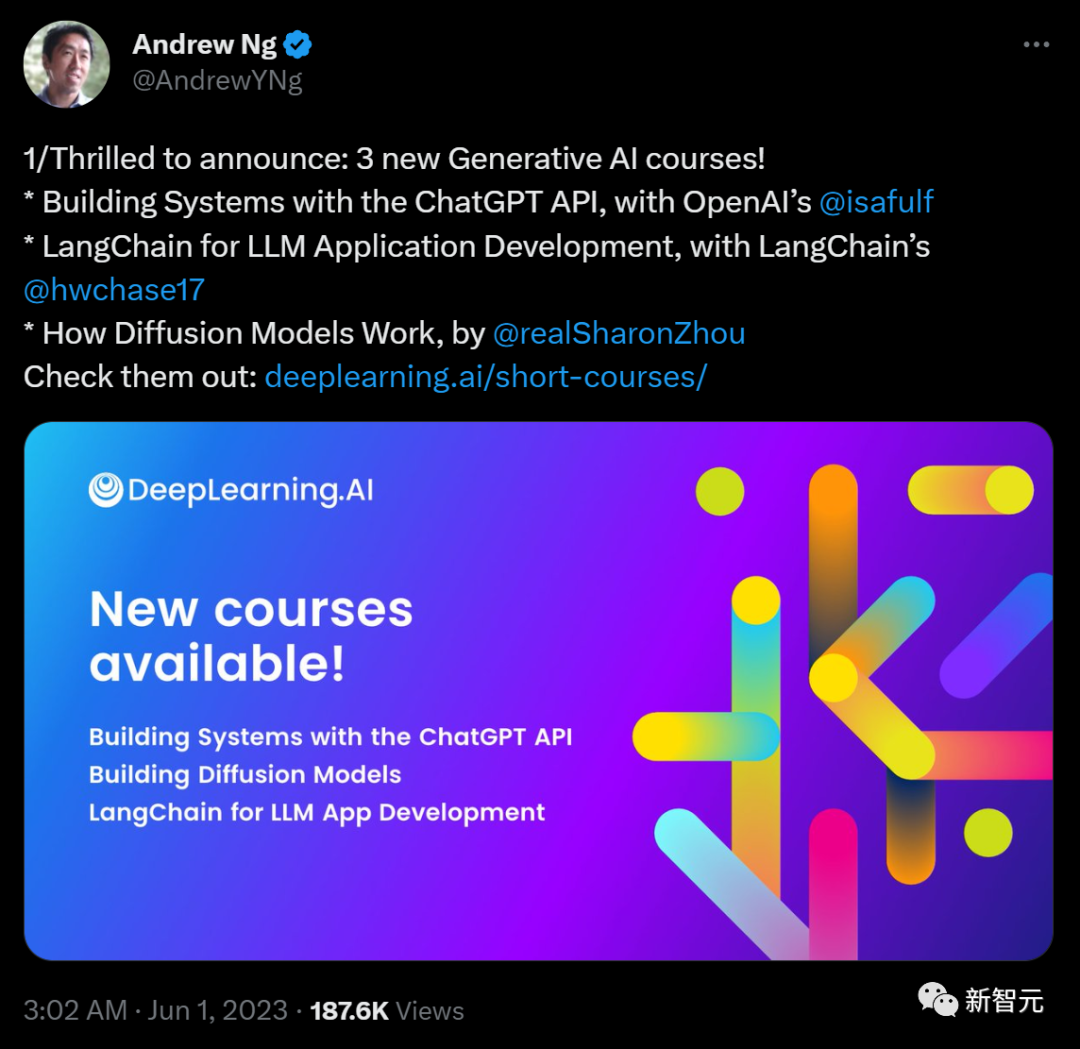
Ng Enda has sent good news to the AI community again.
Today, Andrew Ng announced on Twitter that three new generative AI courses are online.

These three courses include——
1. Using OpenAI ChatGPT API Building System: With this course, go beyond a single prompt and learn to build complex applications that use multiple API calls to LLM. At the same time, you will learn how to evaluate the output of LLM to ensure safety and accuracy, and drive iterative improvements.

2. LangChain for LLM application development: By learning this powerful open source tool, you can build applications that use LLM Applications include chatbot memory, question answering on documents, and LLM agents that can decide what actions to take next.

3. How the diffusion model works: This course allows you to learn how the diffusion model Technical details, these models support Midjourney, DALL·E 2 and Stable Diffusion. You can also generate your own working Jupyter code for video game sprites.

Note that these courses are free for a limited time, and the duration of each course is 1- 1.5 hours.
In this course, you can learn how to automate complex workflows by continuously calling large language models.

Contains:
· Constructing prompts that interact with previous prompts chain.
· Build Python code to interact with existing and new prompt systems.
· Build a customer service chatbot using the techniques in the course.
These skills can be applied to real-world scenarios including classifying user queries into chat agent responses, assessing the security of user queries, and processing tasks for thought chaining, multi-step reasoning.
Among them, hands-on examples make concepts easy to understand, while built-in Jupyter Notebooks let you seamlessly experiment with code and labs introduced in the course.
This course is suitable for beginners who have a basic understanding of Python. It is also suitable for intermediate and advanced machine learning engineers who want to learn LLM's cutting-edge rapid engineering skills.
In this course, you can learn the basic skills to use the LangChain framework to extend the use cases and functionality of language models in application development. .
Specifically includes:
· Model, prompts and parser: calling LLM, providing prompts and parsing responses
· LLM's memory: memory for storing dialogue and managing limited context space
· Chains: creating sequences of operations
· Documentation Q&A: Apply LLM to your proprietary data and use case requirements
· Agents: Exploring the Powerful Development of LLMs as Inference Agents
At the end of the course, you will have a model that can serve as a starting point for your own exploration of applied diffusion models .
This course will greatly help you expand the possibilities of leveraging powerful language models, and in a few hours, you can create incredible applications.
This course is suitable for beginners who need to master basic Python knowledge.
In this section, you can gain an in-depth understanding of the diffusion process and the models that perform it.

This class goes beyond simply bringing in a pre-built model or using an API, it teaches you to start from scratch Construct a diffusion model.
Specifically includes:
· Explore the cutting-edge world of diffusion-based generative AI and create your own diffusion model from scratch.
· Gain insights into diffusion processes and the models that drive them, going beyond pre-built models and APIs.
· Gain practical coding skills through labs sampling, training diffusion models, building neural networks for noise prediction, and adding context to personalized image generation.
By the end of the course, you will have a model that can serve as a starting point for your own exploration of applying diffusion models.
Among them, hands-on examples make concepts easy to understand, while built-in Jupyter Notebooks let you seamlessly experiment with code and labs introduced in the course.
This is an intermediate-level course that requires knowledge of Python, Tensorflow, or Pytorch.
The above is the detailed content of Andrew Ng's three new courses are released in a row, teaching you step by step how to build applications using ChatGPT API. For more information, please follow other related articles on the PHP Chinese website!




